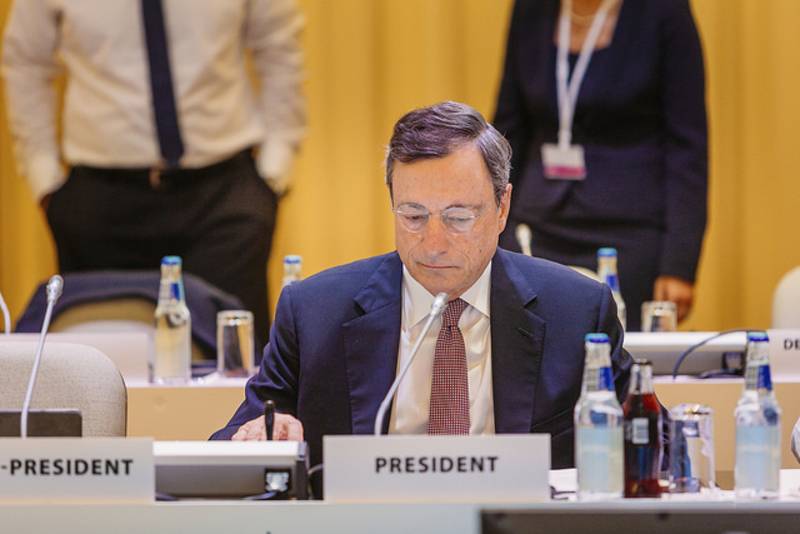The European Commission: saving failing banks is in their liquidation
Ralitsa Kovacheva, May 31, 2010
 It is not a problem a bank to fail. The question is how this should be done without a severe impact on the system. This lesson from the crisis is at the heart of the European Commission's proposal for the establishment of special resolution funds in order to organize the bankruptcy of financial institutions in a proper and harmless way for the financial system.
It is not a problem a bank to fail. The question is how this should be done without a severe impact on the system. This lesson from the crisis is at the heart of the European Commission's proposal for the establishment of special resolution funds in order to organize the bankruptcy of financial institutions in a proper and harmless way for the financial system.
The main premise, which is at the core of the Commission’s proposal, is that it should not again be allowed the problems of the banks to be funded with taxpayers' money. The logic is similar to the “polluter pays” principle, applied in the environment policy. A necessary indication is that the purpose of the proposal is the financial sector to bear the burden of future crises rather than "returning" public money spent in the current crisis.
It is also important to consider the problem of "moral hazard", namely the fear that such a "reinsurance" (collection of fees in a special fund) will encourage banks to take higher risks. According to the Commission, “resolution funds must not be used as an insurance against failure or to bail out failing banks” but rather to facilitate the procedure of bankruptcy. It is also important taxes paid by banks to be calculated properly, so that the increased financial burden would not to be transferred on the price of credits to the real economy and on the regular customers of the banks.
One of the most contentious issues before the Commission's proposal was presented was whether a common European resolution fund should be established or separate national funds. Both, but one by one, the Commission responds. According to it, “In principle, pooling resources into a single pan EU resolution fund would deliver clear benefits by: increasing risk diversification; delivering economies of scale; reducing the amount that would be subject to burden sharing; providing the right incentives for cooperation; speeding up decision-making; and guaranteeing a level playing field.”
However, despite these obvious benefits, the Commission recognises that it would be very difficult to begin with the creation of an EU Resolution Fund in the absence of an integrated EU supervisory and crisis management framework. “For that reason, an appropriate first step could be a system based around the establishment of a harmonized network of national funds linked to a set of coordinated national crisis management arrangements. These arrangements are a first step and would be reviewed by 20149 with the aim of creating EU integrated crisis management and supervisory arrangements, as well as an EU Resolution Fund in the longer term.”
Despite the national character of the funds it is very important that they act in common terms and principles. The commission warns, that “failure to adopt an EU approach with respect to bank resolution funds could result in the unilateral imposition of resolution levies domestically and thus risk competitive distortions between national banking markets.” It could also lead to overlapping of levies in the case of cross-border banks and could make attempts to resolve future crises more complex or even impossible.
"Only EU action would ensure that banking groups operating in more than one Member State were subject to similar requirements concerning resolution funds, and thus a broadly level playing field, avoid unwarranted compliance costs for cross-border activities and promote further integration within the Internal Market.”
The Commission takes the view that resolution funds should be built up “ex ante” on basis of contributions from banks, rather on an “ex post” basis, which will again cause the need for intervention with public funds. At this stage, it does not seem appropriate to the Commission to extend resolution funds to other financial institutions such as investment funds or insurance institutions, which have a number of peculiarities.
A key question about the resolution funds is how to determine the amount of taxes paid by banks. On the one hand, it is necessary to raise enough resources, and on the other - “to do so in a way which incentivises appropriate behaviour, mitigating the risk of resolution”. It is yet to be decided whether the contribution of individual banks will be based on the institution's liabilities, its assets, or its profits.
“Regardless of the basis finally chosen, the Commission considers that it should at least comply with the following principles: a) avoid any possible arbitrage, b) reflect the appropriate risks; c) take into account the systemic nature of certain financial entities, d) be based on the possible amounts that could be spent if resolution becomes necessary and e) avoid competition distortions.”
According to the IMF, the net direct fiscal cost of the crisis has averaged 2.7% of  GDP for advanced G20 countries although amounts pledged, including guarantees and other contingent liabilities averaged 25% of GDP. The aim of the recently launched Swedish bank stabilization fund is to accumulate an amount of 2.5% of GDP in 15 years. The amount of the tax paid by banks and other credit institutions is 0.036% per year levied on certain parts of the institution's liabilities. Germany proposed a systemic banking fee to be collected in a stabilization fund, worth the total amount to 1 billion euro annually.
GDP for advanced G20 countries although amounts pledged, including guarantees and other contingent liabilities averaged 25% of GDP. The aim of the recently launched Swedish bank stabilization fund is to accumulate an amount of 2.5% of GDP in 15 years. The amount of the tax paid by banks and other credit institutions is 0.036% per year levied on certain parts of the institution's liabilities. Germany proposed a systemic banking fee to be collected in a stabilization fund, worth the total amount to 1 billion euro annually.
What is the task of bank resolution funds? To contribute to financing and organizing orderly resolution of distressed financial entities, but not to bail out troubled institutions. In its proposal the Commission stresses that “although resolution funds will not be used to recapitalise banks, they will need to be sufficiently resourced to cope with different resolution costs, and the approach taken will need to be tailored to entities of different sizes and nature.”
In general the procedure, after the fund takes action, foresees firstly a risk assessment and, secondly - development of a recovery plan and a resolution plan. If the recovery plan would not work, the resolution one would be enforced into force. The resolution funds are expected to cover activities like financing a bridge bank, total or partial transfer of assets and/or liabilities, a good bank/bad bank split, covering administrative costs, legal and advisory fees, as well as the need to preserve certain vital functions of the banks – such as payments systems.
Given that obviously the size of a bank resolution fund is likely to be significant in most economies, the governance rules for such a fund are of paramount importance, the Commission notes. Contributions from banks could either be allocated to the general budget or to a fund. “Some Member States could find it attractive to use these contributions to reduce their public deficit”, the Commission presumes. But warns, that in the longer term, it could make a bad joke to the governments.
“The Commission therefore takes the view that bank resolution funds should remain separate from the national budget and dedicated only to resolution costs.” Functional independence from government would ensure that the funds were strictly reserved to pay for resolution measures, the proposal reads. It is also the national governments to consider that “the use of bank resolution funds will need to respect the EU state aid rules”.
The details of the governance arrangements will have to be further developed, but these have to answer three main questions:
How should the money collected be held: ”Investment of funds would need to be in a geographically well diversified portfolio in highly liquid non-bank assets with low credit and market risk and in a way that supports the real economy.”
The other two questions are under what conditions the funds should be used to resolve banks and how to decide the allocation of costs payable by funds in case of a cross-border resolution. The Commission is still to be working on the answers, but it intends to put in place a harmonised resolution framework which should determine when and how resolution funds can be used and also a special procedure for cross- border resolution.
The Commission explains that resolution funds are a necessary part of the new EU crisis management framework. The objective of this framework is to ensure that Member State authorities have common tools that can be used in a coordinated manner in the event of major banking failures, protecting the broader financial system, avoiding costs for taxpayers and ensuring a level playing field. (The Commission has already proposed measures to strengthen capital requirements reform the EU supervisory architecture and will in July come forward with a proposal to strengthen existing Deposit Guarantee Schemes.)
The Commission will adopt in October 2010 a roadmap setting out the timetable, concrete measures, tools and plans for a complete EU framework for crisis management. The intention is relevant legislative proposals regarding both crisis management measures and tools and resolution funds to be presented by early 2011.
The current Commission's proposal will be discussed by EU leaders at the European Council on 17 and 18 June. The topic of financial regulation will be a key issue for the G20 meeting too, to be held in Toronto on 26 and June 27. European Commission calls on its representatives there to advocate its proposal in order to achieve an agreement on common principles as rapidly as possible and to avoid the development of divergent national approaches.
 The United States already has two bills on financial regulation – the first proposed by President Barack Obama and approved by the Senate and the second, supported by the House of Representatives. The two bills have to be integrated and a final version to be approved. The IMF also issued a proposal for a global bank tax, which is to be refined and presented to the leaders of the G20. It is known, however, that some countries are firmly against it, but it is also clear that if not implemented globally, any imposed measures would not have the expected effect.
The United States already has two bills on financial regulation – the first proposed by President Barack Obama and approved by the Senate and the second, supported by the House of Representatives. The two bills have to be integrated and a final version to be approved. The IMF also issued a proposal for a global bank tax, which is to be refined and presented to the leaders of the G20. It is known, however, that some countries are firmly against it, but it is also clear that if not implemented globally, any imposed measures would not have the expected effect.
Another tough question is whether, despite the ambition to protect taxpayers, the additional financial burden on banks will be ultimately paid by their customers.
 Mario Draghi | © ECB
Mario Draghi | © ECB Vladislav Goranov, Sven Sester | © Council of the EU
Vladislav Goranov, Sven Sester | © Council of the EU Tsakalotos, Djisselbloem, Gramegna | © Council of the EU
Tsakalotos, Djisselbloem, Gramegna | © Council of the EU